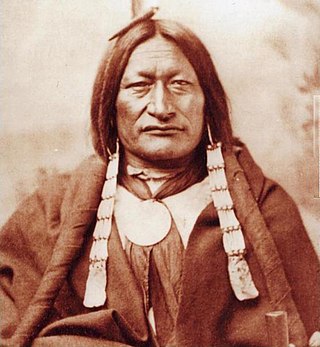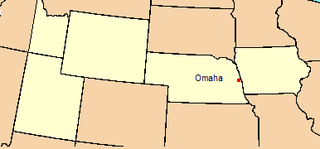Bibliography
- Ephriam D. Dickson III, "Capturing the Lakota Spirit, Photographers at the Red Cloud & Spotted Tail Agencies," Nebraska History, Spring/Summer 2007.
Daniel Sedgley Mitchell (1838-1929) was an American photographer best known for his series of stereoscopic views of the Black Hills in 1876, his Native American portraits from the Red Cloud Agency in 1877, and his photographs of the Oklahoma Land Rush in 1889.
Born in 1838 in York County, Maine, Mitchell began his photographic career as an errand boy in a daguerreotype gallery in Maine at the age of nine. During his early years he worked in a number of photographic galleries, ranging from New York City to Boston to Canada.
About 1874, Mitchell departed Boston, leaving behind his wife and children. He apparently first stopped briefly in Kansas. In late 1875, he had opened a studio on Eddy Street in Cheyenne, Wyoming Territory. In the spring of 1876, he headed north to the Black Hills with his camera, spending the summer making images among the mines. After returning to Cheyenne, he sold his Black Hills stereoviews and continued to produce portraits for the public. In January 1877, he produced portraits of Brigadier General George Crook and of the court-martial board for Colonel Joseph J. Reynolds. In the spring of 1877, he joined partnership with Joseph H. McGowan and traveled along the Union Pacific Railroad, taking portraits and selling his Black Hills views. In the fall of 1877, he apparently visited the Red Cloud Agency where he took portraits of a majority of the Oglala and Arapaho headmen.
In the spring of 1878, Mitchell and McGowan settled in Omaha where they established the Great Western Photographic Company. Their focus was to mass-produce and market Mitchell's two series of photographs as well as a third series, taken by Charles Howard. The partnership dissolved in the fall of 1878. Mitchell then opened a portrait studio in Omaha, in partnership with May J. Cannell, whom he later married.
Mitchell next moved to Norfolk, Nebraska; then to Galesburg, Illinois, and finally in 1889, moved to Guthrie, Oklahoma Territory, where he produced an important photographic series of the land rush. Mitchell died in Guthrie in 1929.
The largest surviving collection of Mitchell's Indian portraits from the Red Cloud Agency were preserved by Captain John G. Bourke, former aide-de-camp to Brigadier General George Crook. Some of the images are pasted within his diaries, preserved at the U.S. Military Academy at West Point. Another large number of images were donated to the National Anthropological Archives at the Smithsonian Institution. The Nebraska State Historical Society also preserves a number from Bourke's collection.

George R. Crook was a career United States Army officer who served in the American Civil War and the Indian Wars. He is best known for commanding U.S. forces in the 1886 campaign that led to the defeat of the Apache leader Geronimo. As a result, the Apache nicknamed Crook Nantan Lupan, which means "Grey Wolf."

Red Cloud was a leader of the Oglala Lakota from 1865 to 1909. He was one of the most capable Native American opponents whom the United States Army faced in the western territories. He defeated the United States during Red Cloud's War, which was a fight over control of the Powder River Country in northeastern Wyoming and southern Montana. The largest action of the war was the 1866 Fetterman Fight, with 81 US soldiers killed; it was the worst military defeat suffered by the US Army on the Great Plains until the Battle of the Little Bighorn 10 years later.

Crazy Horse was a Lakota war leader of the Oglala band in the 19th century. He took up arms against the United States federal government to fight against encroachment by white American settlers on Native American territory and to preserve the traditional way of life of the Lakota people. His participation in several famous battles of the Black Hills War on the northern Great Plains, among them the Fetterman Fight in 1866, in which he acted as a decoy, and the Battle of the Little Bighorn in 1876, in which he led a war party to victory, earned him great respect from both his enemies and his own people.

The Battle of the Rosebud took place on June 17, 1876, in the Montana Territory between the United States Army and its Crow and Shoshoni allies against a force consisting mostly of Lakota Sioux and Northern Cheyenne Indians during the Great Sioux War of 1876. The Cheyenne called it the Battle Where the Girl Saved Her Brother because of an incident during the fight involving Buffalo Calf Road Woman. General George Crook's offensive was stymied by the Indians, led by Crazy Horse, and he awaited reinforcements before resuming the campaign in August.

The Sioux Wars were a series of conflicts between the United States and various subgroups of the Sioux people which occurred in the later half of the 19th century. The earliest conflict came in 1854 when a fight broke out at Fort Laramie in Wyoming, when Sioux warriors killed 31 American soldiers in the Grattan Massacre, and the final came in 1890 during the Ghost Dance War.
The Dull Knife Fight, or the Battle on the Red Fork, part of the Great Sioux War of 1876, was a battle that was fought on November 25, 1876, in present-day Johnson County, Wyoming between soldiers and scouts of the United States Army and warriors of the Northern Cheyenne. The battle essentially ended the Northern Cheyennes' ability to continue the fight for their freedom on the Great Plains.

He Dog. A member of the Oglala Lakota, He Dog was closely associated with Crazy Horse during the Great Sioux War of 1876-77.

Spotted Tail was a Sichangu Lakota tribal chief. Famed as a great warrior since his youth, warring on Ute, Pawnee and Absaroke (“Crow”), and having taken a leading part in the Grattan Massacre, he led his warriors in the Colorado and Platte River uprising after the massacre performed by John M. Chivington's Colorado Volunteers of the peaceful Cheyenne and Arapaho camping on Sand Creek, but declined to participate in Red Cloud's War.

Little Hawk (1836–1900) was an Oglala Lakota war chief and a half-brother of Worm, father of Crazy Horse ....

The Battle of Powder River, also known as the Reynolds Battle, occurred on March 17, 1876, in Montana Territory, United States as part of the Big Horn Expedition. The attack on a Northern Cheyenne and Oglala Lakota Indian encampment by Colonel Joseph J. Reynolds initiated the Great Sioux War of 1876. Although destroying a large amount of Indian property, the attack was poorly carried out and solidified Northern Cheyenne and Lakota Sioux resistance to the U.S. attempt to force them to sell the Black Hills and live on a reservation.

Frank Albert Rinehart was an American photographer who captured Native American personalities and scenes, especially portrait settings of leaders and members of the delegations who attended the 1898 Indian Congress in Omaha.

Touch the Clouds was a chief of the Minneconjou Teton Lakota known for his bravery and skill in battle, physical strength and diplomacy in counsel. The youngest son of Lone Horn, he was brother to Spotted Elk, Frog, and Roman Nose. There is evidence suggesting that he was a cousin to Crazy Horse.
A private in the Fourth Infantry, Charles Howard served as photographer for the Stanton Expedition in 1877, traveling throughout eastern Wyoming, western Nebraska and into the Black Hills of Dakota Territory.

David Rodocker was an American photographer active in Champaign, Illinois in the 1860s, Winfield, Kansas, 1871–1919, and traveling through Black Hills, 1877.

The Department of the Platte was a military administrative district established by the U.S. Army on March 5, 1866, with boundaries encompassing Iowa, Nebraska, Dakota Territory, Utah Territory and a small portion of Idaho. With headquarters in Omaha, the district commander oversaw the army's role initially along the Overland route to Salt Lake City, then later the construction route of the Union Pacific Railroad. The district also included the Montana road through eastern Wyoming. The district was discontinued when the Army's command was reorganized in 1898.

The Great Sioux War of 1876, also known as the Black Hills War, was a series of battles and negotiations that occurred in 1876 and 1877 in an alliance of Lakota Sioux and Northern Cheyenne against the United States. The cause of the war was the desire of the US government to obtain ownership of the Black Hills. Gold had been discovered in the Black Hills, settlers began to encroach onto Native American lands, and the Sioux and the Cheyenne refused to cede ownership. Traditionally, American military and historians place the Lakota at the center of the story, especially because of their numbers, but some Native Americans believe the Cheyenne were the primary target of the American campaign.

Yellow Bear, Mato Ǧí, was an Oglala Lakota leader.
William Gentles (c.1830–1878) was a private in the U.S. Army who is generally acknowledged as the soldier who bayoneted the Oglala war leader Crazy Horse in 1877.

The Northern Cheyenne Exodus, also known as Dull Knife's Raid, the Cheyenne War, or the Cheyenne Campaign, was the attempt of the Northern Cheyenne to return to the north, after being placed on the Southern Cheyenne reservation in the Indian Territory, and the United States Army operations to stop them. The period lasted from 1878 to 1879.
The Big Horn Expedition, or Bighorn Expedition, was a military operation of the United States Army against the Lakota Sioux and Cheyenne Indians in Wyoming Territory and Montana Territory. Although soldiers destroyed one Northern Cheyenne and Oglala Lakota village at the Battle of Powder River, the expedition solidified Lakota Sioux and Northern Cheyenne resistance against the United States attempt to force them to sell the Black Hills and live on a reservation, beginning the Great Sioux War of 1876.